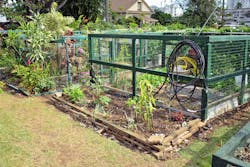From reducing flooding to lessing demand on public stormwater drainage systems; supporting healthy streams and rivers; and creating healthier, more sustainable communities, a lot of work goes into managing stormwater to meet project goals and objectives. To achieve these goals, communities are opting for green infrastructure improvements to enhance or replace grey infrastructure. Green infrastructure improvements aim to perform ecological services and be an engineered enhancement that draws the community together. In many cities, residents of low-income communities as well as communities of color have long been excluded from land use decisions, resulting in neighborhoods that are often paved over and lacking in green spaces that could absorb stormwater, filter contaminated urban runoff, and draw the community together.
By connecting people to their environments with urban installations of green infrastructure, neighborhoods can be transformed. Communicating the value of green infrastructure, placing stormwater management goals front and center in planning efforts, as well as listening, engaging, and building trust among community stakeholders are all keys to success.
The Ecological Service
As city neighborhoods were built, the combined sewer system was engineered to carry sewage and stormwater away as quickly as possible. In many cities, both stormwater and sanitary sewage flow into the same pipe. In dry weather, all sewage is conveyed to the wastewater treatment plant and treated before being released. During wet weather, however, a combination of stormwater and sewage enter the sewer and many wastewater treatment plants cannot handle the deluge. As a result, untreated wastewater can overflow into our creeks, rivers and lakes, resulting in a combined sewer overflow (CSO).
Many older cities have a combined sewer system that continues to function similarly today. By diverting stormwater from the sewers, capturing and retaining it onsite, green infrastructure reduces the amount of stormwater entering the sewers and reduces the number of CSO events, protecting public health and the environment. The Community Service Through transparency, public awareness, open and honest communication, and prompt and respectful customer service, stormwater management and green infrastructure improvements can also be a series of enhancements that draw the community together. Through providing open green space with these enhancements, relationships and trust with communities grow— interaction by interaction, meeting by meeting, and project by project. When developing a green infrastructure plan, you should also be asking:
- How can we best engage the community so that they tell us what they want and need?
- Can the design options we are suggesting include additional benefits that help advance social equity, promote racial and environmental justice, and improve community well-being?
- How do we find out what they want and need? First and foremost, unless you live in the community, you do not intimately know the wants and needs of the residents. It is your job to ask questions to know how to best address their wants and needs.
Advisory Board
Start by establishing community advisory boards (CABs) for each neighborhood, as well as other stakeholders, to develop an intention statement. Each CAB consists of a groups of individuals with ties to and knowledge of their neighborhood. It should include representatives from community-based organizations as well. Applications to participate on a CAB should be open to the public, and compensation for time and travel and other necessities should be considered on an as-needed basis. The primary focus of CABs should be to provide feedback and insight into preliminary engagement and stormwater management strategies as they are being developed. CAB members lead engagement within the community by participating in community events, socializing the program with the community, gathering feedback from the community, and sharing feedback with city leadership and the program’s technical teams to ensure the best possible outcomes.
Intention Statement
The CABs should develop an intention statement that ensures everyone is heard. This statement should capture the project mission and guide the work throughout the planning process. A sample intention statement might be: The City of _____ will work closely with the community to co-develop a series of layered stormwater and green infrastructure adaptation approaches that provide protection from stormwater events. Together, we will draw on prior planning and local knowledge to propose buildable projects plus responsive policies and programs with lasting social, environmental and economic benefits to be experienced by those most in need. We will seek to produce a stormwater management roadmap that protects and creates value for the ______________ communities and all who share in the health of the ______________ (waterway).
Engagement Plan
Develop an engagement plan that establishes multiple channels of communication for residents to share the latest study findings, provide feedback and input, and participate in developing solutions throughout the planning process. When developing stormwater management plans for the cities of Buffalo, New York, and Pittsburgh, Pennsylvania and coastal management plans for Boston, Massachusettes, Arcadis used open house events, online surveys, community presentations, stakeholder interviews, outdoor postings, and online engagements to involve the community. Arcadis also found conversations with members of local religious communities helpful thus enlisted their support to identify advisory board members and to communicate the value and importance of getting involved.
In Boston, the project team directly engaged with more than 550 community members from one neighborhood. The results of a strong engagement process will be felt for years to come. Stakeholders help shape the development of the stormwater management and green infrastructure solutions and priorities, which help to secure additional benefits for each neighborhood and community resident. With this information, the focus turned to identifying design decisions for additional benefits that help advance social equity, promote racial and environmental justice, and improve community well-being. Aside from protecting the environment, reducing flooding, and creating healthier water bodies for more sustainable communities, the green design options suggested have other benefits for the community. Examples include design options that provide new recreational and cultural amenities; design options that include a community gardening program to reduce food insecurity; and design options that include trails and walkways to connect people to neighboring communities.
According to the National Socio- Economic Development Center, community gardens as a form of green infrastructure are often overlooked. For instance, they reduce urban heat islands, provide ecosystem services, and increase stormwater retention. They also support sociological goals of trust-building, participation and food security. These garden spaces sometimes spring up on contested, abandoned or brownscape properties with toxic residues and, historically, have been challenged by other urban priorities such as development and privatization. The National Recreation and Park Administration developed a resource guide for planning, developing and implementing green infrastructure for stormwater management in parks. With a goal of increasing social equity, they suggest combining green stormwater infrastructure into park retrofits and new park development. This can help ensure that open space is used to its full potential by providing multiple environmental and social benefits while helping cities grow or revitalize more equitably.
During the selection process, it is important to ensure parks contribute to social equity and will prioritize underserved communities. Truly engaged community members actively participate in the design process and provide meaningful feedback, not just initial ideas or general desires. Equity must also be addressed at a system-, city- or county-wide scale to ensure resources are allocated fairly and investments target the area of greatest need. Some strategies that can be employed to ensure equity are to:
- Develop and incorporate levels of service standards that encourage equitable access to parks when siting projects.
- Ensure that community outreach efforts involve all stakeholders, making efforts to include groups that have historically been underrepresented and underserved.
- Create a participatory process as much as possible.
- Accommodate as many ages, abilities, activity levels, and amenities as possible.
- Use equitable employment practices.
- Make efforts to recruit and hire parks and recreation employees that reflect the demographics of the communities in which they work.
- Utilize tools to help incorporate equity considerations into the decisionmaking process.
- Keep the design adaptive and remain responsive to community feedback.
Not only are stormwater management goals created to protect the environment and reduce flooding but also to ensure healthier and sustainable communities. The voices of all community members, regardless of socioeconomic background, race, ability or gender, are important in the decision making for these improvements. They bring necessary perspective to the design options that can then better prioritize social equity, racial and environmental justice and community well-being holistically. Stormwater management and green infrastructure projects can have social impacts that go beyond the natural environment







